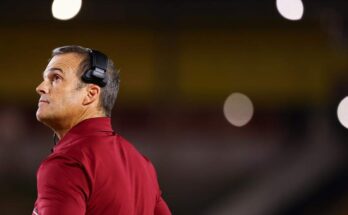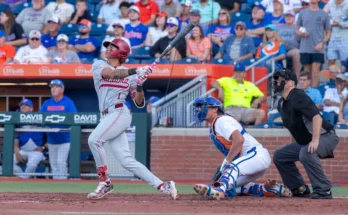Mark Pope’s First Kentucky Team Faces Big Expectations in 2025-26 as a Rebuilt Roster Aims for Immediate National Relevance
What should the expectations be for Mark Pope’s 2025–26 Kentucky basketball team? That’s the question Kentucky fans, media, and college basketball analysts are all trying to answer as the Wildcats enter a new era. After 15 years of John Calipari’s high-profile recruiting and roller-coaster results, Pope inherits a proud but impatient fanbase hungry for consistency, competitiveness, and deep tournament runs. Pope’s challenge is steep: follow a Hall of Famer, reestablish a winning identity, and navigate a dramatically different roster — all while restoring Kentucky to its rightful place as a college basketball power. So what should the expectations be? In short: competitiveness in the SEC, a solid national ranking, and the realistic goal of a Sweet Sixteen — with upside for more if things click early.
Let’s start with what Pope is inheriting — or, more accurately, what he isn’t. The 2024–25 Wildcats flamed out early in March once again, closing the door on the Calipari era with a wave of frustration. After years of early tournament exits, inconsistent rotations, and questionable player development, Kentucky needed a fresh voice and new direction. Pope brings energy, purpose, and a different vision. While not the splashiest hire, he offers something that Kentucky lacked in recent years: offensive structure, modern spacing, and a plan that doesn’t rely entirely on freshmen figuring it out on the fly. That change in approach has already been reflected in how he rebuilt the roster.
Pope didn’t waste any time assembling his first team. Through a mix of returning players, high-upside transfers, and a few freshmen, Kentucky now looks like a program designed to compete now — not one in rebuilding mode. Key returners like Adou Thiero, if healthy, offer experience and versatility. The incoming transfer group includes proven mid-major stars and Power Five contributors who fit Pope’s system, including shooters, playmakers, and defenders. It’s a roster that doesn’t rely on one-and-done stars, but rather on a cohesive, older group capable of executing a detailed game plan on both ends of the floor.
One of the main reasons expectations should be cautiously optimistic rather than sky-high is the realistic understanding that chemistry takes time. Pope is blending players from vastly different systems and backgrounds. Even with a summer and fall to install his schemes, the early part of the season may feature growing pains. His offense emphasizes ball movement, floor spacing, and quick decision-making — a stark contrast to the often isolation-heavy sets of the previous regime. His defense requires communication, switchability, and constant effort. Buying into this new culture takes time, and not every player will adjust at the same speed.
That said, the roster makeup is encouraging. Pope has long valued shooting, and this team should have plenty. Several of the incoming transfers, including veterans with range and confidence, can stretch the floor, giving Kentucky a dimension it often lacked under Calipari. Rather than clogging the paint with non-shooters, Pope’s offense is designed to give playmakers driving lanes and kickout options. This will allow Kentucky to play a more modern, efficient brand of basketball that can hang with today’s elite teams.
Equally important is the emphasis on experience. Gone are the days when Kentucky would start four or five freshmen and hope they’d be ready by February. Pope’s squad will likely feature multiple juniors and seniors in key roles. That maturity should pay dividends in close games and tough road environments — two areas where Kentucky often struggled in recent seasons. With battle-tested players who’ve already logged big minutes at the college level, this group won’t be overwhelmed by the moment. They might not be as flashy or hyped as previous UK teams, but they’re more likely to know how to win.
In terms of style, fans can expect a much more disciplined, fluid product. Pope’s teams at BYU consistently ranked among the top in offensive efficiency and ball movement. He values the extra pass, open threes, and unselfish play. Expect more ball screens, five-out sets, and read-and-react actions that empower multiple players to make plays — not just one dominant guard or wing. This kind of system not only prepares players for the next level but also increases Kentucky’s margin for error in tight games. It’s no longer about one or two guys needing to be great every night — it’s about the team making smart decisions and executing consistently.
Of course, the SEC is as brutal as ever. Tennessee, Alabama, Auburn, Arkansas, and others are loading up on talent, both high school and portal-based. Kentucky will face a gauntlet of top-25 matchups throughout the season. That’s why immediate expectations should be tempered. A 12–6 SEC record would be a major success in Pope’s first season, especially considering the transition and the strength of the league. Finishing in the top four of the SEC should be a realistic goal — and would likely result in a solid seed come NCAA Tournament time.
What about March? That’s where Kentucky fans are rightfully focused. After nearly a decade of disappointment in the NCAA Tournament, the expectation — and perhaps the minimum bar for success — is winning at least two games. A Sweet Sixteen appearance would show progress and quiet a lot of early doubters. It would also validate Pope’s roster-building approach and earn trust with recruits and fans alike. Anything beyond that — a potential Elite Eight run or Cinderella-like Final Four appearance — would be icing on the cake and proof that Kentucky made the right hire.
It’s also worth noting that Pope understands the weight of the job. He played at Kentucky, he’s coached at every level, and he knows what the fanbase demands. He won’t be overwhelmed by the spotlight, and he brings a sense of purpose that should resonate throughout the program. His energy, attention to detail, and passion for the school are already evident. That buy-in is crucial. Kentucky doesn’t need someone trying to “survive” the job — it needs someone who embraces it. Pope does.
Off the court, recruiting remains a major storyline. Pope has made it clear he plans to recruit internationally and through the portal as much as from traditional high school pipelines. That flexibility is essential in today’s game. If he can consistently land players like Sayon Keita or retain and develop multi-year talents, Kentucky will remain a national contender. But 2025–26 is about more than just recruiting for the future — it’s about reestablishing the program’s identity and regaining national respect. That starts with how this team competes every night.
There’s also a psychological benefit to the transition. The Calipari era had grown stale — not just in results, but in energy. A fresh face, a fresh system, and a fresh culture can reignite the fanbase and the locker room. Players are likely to be more empowered under Pope, more involved in the process, and more connected to one another. Team chemistry, often overlooked, could be one of this squad’s hidden strengths. That kind of unity can be the difference between 18 wins and 25 wins, between a first-round exit and a tournament run.
Realistically, the 2025–26 Kentucky team won’t be ranked No. 1 in the preseason. It probably won’t be the most talented roster Pope ever assembles. But it has the potential to be one of the most cohesive, mature, and competitive teams in the country. And that’s exactly what the program needs right now — a team that plays hard, plays smart, and plays together. The Big Blue Nation doesn’t need another hype machine. It needs results. Pope knows that, and he’s building accordingly.
The bottom line is this: Mark Pope’s first Kentucky team should be judged not by whether it wins a national title immediately, but by whether it competes like a team that could. That means finishing in the upper half of the SEC, earning a top-6 seed in the NCAA Tournament, and winning multiple games in March. It means developing players throughout the season, adjusting to adversity, and never letting effort be a question. It means bringing pride back to Rupp Arena and making the fanbase believe again. And if those boxes are checked, the foundation for a long and successful Pope era will be firmly in place.
So what should the expectations be for the 2025–26 Wildcats? Solid, but not sky-high. Competitive, but not perfect. They should be a 22–25 win team, a top-four SEC contender, and a Sweet Sixteen threat. If the chemistry develops and the system clicks, they could go further. But even if they don’t, the real win would be establishing a new standard — one that blends Kentucky’s tradition with a fresh vision. And that’s exactly what Mark Pope is here to do.



